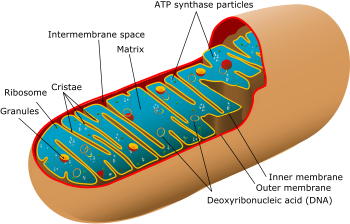| Mitochondria are organelles surrounded by membranes, distributed in the cytosol of most eukaryotic cells. Its main function is the conversion of potential energy of pyruvate molecules into ATP. (Photo credit: Wikipedia) |
So what are Numts upto?
To be honest, nobody really knows why numts exist. There are a few theories though that have been put to explain the behaviour of mitochondria and the existence of numts.
A very plausible explanation is that the presence of numts is part of an extremely long process of integrating the mitochondria into our genomes. Having uploaded its genetic information into the cell’s nuclear databank, the mitochondria can continue to carry out their regular function of energy production without having to bother about their own reproduction. In a way, one could also say that mitochondria are outsourcing this function just like they have outsourced production of certain proteins to the cell in the past. Over a period of time (which in this case is a few more million years), mitochondrial DNA will be entirely transferred to the nucleus, mitochondria will become a true cell organelle and its genetic control will be handled by the cell’s nucleus, thereby completing the integration.
The other explanation is that numts are mitochondria’s way to ensure that its genetic information is safely stored. As power houses of the cell, mitochondria are under severe oxidative stress at all times. As we all know, oxidative stress can severely damage stored genetic information and also obstruct DNA repair mechanisms.With numts, mitochondria are creating a backup of the nuclear information, so that it can be brought back later, when need be. How are mitochondria doing something of this sort, is something we do not really know at this point in time. However, one thing is for sure, these mighty chondria are pulling some extreme feats every single day.
References:
Hazkani-Covo, E., & Graur, D. (2006). A Comparative Analysis of numt Evolution in Human and Chimpanzee Molecular Biology and Evolution, 24 (1), 13-18 DOI: 10.1093/molbev/msl149
Hazkani-Covo, E., Zeller, R., & Martin, W. (2010). Molecular Poltergeists: Mitochondrial DNA Copies (numts) in Sequenced Nuclear Genomes PLoS Genetics, 6 (2) DOI: 10.1371/journal.pgen.1000834







